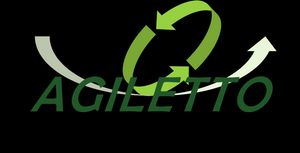Are you willing to let go of control to achieve true business agility?
SAFe recently released updates, refining guidance on Portfolio Leadership and Business Value. These updates are valuable, offering practical tips for organizations on their Agile journey. But they also prompt a deeper question: are these frameworks, roles, and structures enough to achieve true business agility? Or, to make Agile genuinely transformative, do leaders need to confront something more fundamental—the willingness to let go of control?
In this piece, we’ll explore not only the latest SAFe updates but also what it means to foster a culture of true agility. If business agility is the goal, then perhaps it’s time to ask: How much are we willing to let go in order to achieve true Business Agility? So, let's do it!

Clarifying Roles—Helpful or Holding On?
SAFe’s latest push to clarify roles in Portfolio Management may seem like a helpful addition, especially for organizations seeking structure. But let’s pause and ask: does this help us build agility, or does it encourage us to hold on to control? As Agile practitioners, we know the core values emphasize Individuals and Interactions over Processes and Tools. Overly rigid roles risk turning Agile into just another hierarchy, prioritizing control over empowerment.
True business agility doesn’t come from defining roles but from creating an environment where people feel empowered to adapt, collaborate, and lead based on real-time needs. Rather than controlling roles at the Portfolio level, true agility asks leaders to trust their teams to self-organize and connect across boundaries. This is where Agile shines—not as a set of boxes to check but as a way of thinking, connecting, and collaborating.
Now, I’m not saying we don’t need role definitions and clear mandates. They’re valuable—they help build transparency, establish trust, and create the foundation for effective collaboration. A blank page with no structure is hard to trust; clear roles give us a starting point. But those roles should enable agility, not constrain it.
So, what’s the challenge here? It’s a question of trust—and a lot of courage. Do we dare to let go of control, even a little, and trust our people to find the best paths forward? Do we believe in our organization’s ability to reach the goal by empowering people to chart their own course? At the end of the day, Agile isn’t a process; it’s a culture that thrives on trust, autonomy, and collaboration. Culture lives in our interactions, not in job titles or role definitions. When leaders lead with trust and empower teams, that’s when Agile becomes real.
Implementing SAFe—Or Building a Culture?
Reading through the new updates, SAFe continues to emphasize "implementing" Agile at scale. With articles offering "actionable guidance on implementing SAFe," the message is clear: follow the steps to "do SAFe." But if business agility is our destination, should our goal be to implement, or is it something deeper?
Implementation provides structure, and many large organizations naturally gravitate toward this. But true Agile transformation is a cultural shift. The deepest Agile transformations happen not when we follow steps, but when we embrace Agile as a journey—one that prioritizes transparency, adaptability, and continuous learning. SAFe could benefit by shifting its focus from “implementation” to “transformation.” Instead of asking, “How can we implement SAFe?” perhaps leaders could ask, “How can we inspire people and teams to own and drive this change?”
I get why SAFe still emphasizes “implementing” SAFe—it’s a safer starting point, a concrete way for organizations to dive in, and easier to sell. But here’s the challenge: real transformation requires leaders to lean into the unknown. Are we willing to trust our people to lead the journey? Are we open to sharing the responsibility and inviting everyone to shape the path forward? True cultural change happens not when we dictate every step, but when we invite people to co-create the organization’s future.
In the end, Agile is more than a checklist of practices. It’s an invitation to continually evolve, adapt, and grow together. That’s where transformation lives—not in the processes we implement, but in the culture we build.

Business Value—A Shift To Get Behind
If there’s one update from SAFe that resonates deeply with me, it’s the renewed focus on business value. This article on business value highlights a crucial shift: moving from what we think customers want—or even what they say they need—to a focus on creating true business value. For any leader committed to business agility, this is a step in the right direction.
Business value isn’t just earnings, profit, or customer satisfaction. It’s richer, more nuanced, and often harder to define. Many organizations struggle with even identifying who their customer truly is, or pinpointing what aspects of their products or services create the most impact. This article opens the door to a more comprehensive understanding of value—one that encourages leaders to look beyond surface metrics and ask, “What truly matters?”
This focus on business value reminds us of Agile’s real purpose: to deliver meaningful impact, consistently and transparently. It’s a breath of fresh air that aligns perfectly with the idea of letting go of control. When leaders focus on business value, they empower teams to innovate toward that value—without micromanaging every step of the way.
Key Takeaways on Defining Business Value
Here’s the structured approach SAFe provides for understanding and measuring business value:
Identify and Describe What Is Valuable
Real alignment starts with understanding what’s truly valuable to both customers and the organization.Explore Different Dimensions of Value
Business value isn’t one-dimensional. It includes not only hard metrics like revenue but also softer, internal measures like employee engagement and organizational learning.Uncover Unknowns
Assumptions about value can hold us back. Uncovering unknowns demands curiosity, openness, and a willingness to engage in meaningful dialogue.Determine How to Measure Value
Identifying value is just the first step; knowing how to measure it ensures teams can stay aligned and adapt toward it.
These four steps encourage leaders to think beyond traditional metrics and ask, “How can we measure the impact that truly matters?” When we focus on value, we build trust across the organization—trust that our teams are moving in the right direction and delivering meaningful outcomes.
A Perspective on Government and Nonprofit Organizations
One area where SAFe could expand is in its approach to business value for sectors like government and nonprofits. In these contexts, business value doesn’t typically revolve around profit, customer satisfaction, or even keeping costs down. It’s often about public trust, societal impact, or efficient service delivery for the public good.
Even if we measure lagging indicators like quality of service, the real challenge lies in understanding the leading indicators—what genuinely enhances quality of life, and what do citizens truly need? Business agility in these sectors might mean moving beyond Agile and asking, “What does value mean when there’s no single customer or bottom line, when society as a whole is our customer?” Leaders in these sectors could benefit immensely from SAFe guidance tailored to these unique needs, as could politicians. Often, with good intentions, policymakers try to steer how things should be done when they might serve the public better by focusing on why and perhaps a bit of what.
In government and nonprofit work, the Agile journey is not just about delivering; it’s about delivering what truly matters. And that requires letting go of control over the “how” and trusting the people closest to the work to drive the impact.
Conclusion
To sum up, SAFe’s recent updates represent valuable progress, especially in their focus on business value and feedback systems. However, a few shifts could bring it even closer to the true spirit of Agile. Here’s some constructive feedback for the Scaled Agile team:
Dial Up the Focus on Transformation Over Implementation: Transformation is already a theme, but it could be amplified even more, with less focus on "implementation." Rather than building processes and checklists, continue asking, "How do we empower people and organizations to grow and transform?"
Incorporate Perspectives for Government and Nonprofits: There’s an opportunity for more tailored guidance for government and nonprofit sectors, where business value often differs from that of the private sector. And let’s go further! Agile has succeeded in a wide range of contexts—let’s include case studies and guidance that showcase business agility in unexpected fields.
Emphasize Complex, Strategic Thinking: Advanced practices, like systems thinking and decision-making frameworks, could benefit from Agile’s iterative approach. Greater focus on why we think the way we do, rather than just how, would deepen SAFe’s guidance.
Ultimately, true business agility invites leaders to build learning organizations where each project, role, and interaction is an experiment. If SAFe can center future updates around these principles, it will continue to foster real, lasting change—not just implementation.
Finally, I understand the desire for manageable actions. But isn’t this the essence of business agility? To let go of control, trusting in the power of transparency, continuous learning, and the relentless pursuit of value. It’s not always easy, but that’s where true leadership shines. Challenge aside, you have my fullest sympathy. I’m just a leadership/agile/lean coach, and my role is to challenge. The leader’s role is to lead this cultural change—and to truly, authentically, lead the way. It’s not an easy job.
Last updated May 27, 2025
